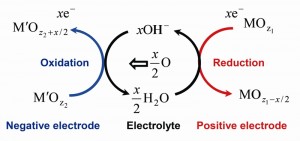“Oxygen rocking” battery Proposal of new battery type with potential for large scale application

There is significant demand for the development of large-scale energy storage that is not only cheap and safe but also made from materials that are abundant. While lithium ion batteries are currently the most widely used, they cannot satisfy all these conditions. In particular, the use of flammable organic electrolyte solutions in lithium ion batteries is a potential safety problem, and one which is critical in the case of large-scale batteries for electric vehicles and electric grids.

Operating principle of oxygen rocking batteries. © Noritaka Mizuno
The directions of arrows indicate discharge. In discharging, cathode and anode materials undergo oxygen extraction and insertion respectively, and oxygen is transferred from the cathode to the anode via the electrolyte.
Professor Noritaka Mizuno at the Department of Applied Chemistry of the University of Tokyo and his research group have proposed and demonstrated a novel lithium-free secondary “oxygen rocking” aqueous battery. In the new battery system, oxygen shuttles between the cathode and anode. The new battery employs iron-based perovskite-related oxides, Ca0.5La0.5FeOz, as the cathode (2.75 ? z ? 3.0) and anode (2.5 ? z ? 2.75). The compound Ca0.5La0.5FeOz can undergo two kinds of reduction and reoxidation of Fe4+/Fe3+ and Fe3+/Fe2+ that are accompanied by reversible and repeatable topotactic oxygen extraction and reinsertion during discharge and charge respectively. The development of more suitable materials for the cathode and anode will enable new practicable oxygen rocking batteries.
Batteries using aqueous electrolytes have advantages in terms of safety and cost in addition to being lithium-free, but they cannot produce high cell voltages due to the potential window of water. Therefore, the new battery system with an aqueous electrolyte is suited for uses where safety and low-cost are more important than high voltage and high energy density, such as stationary batteries which will be needed for the establishment of the smart grid.
This research is supported by the Japan Society for the Promotion of Science (JSPS) through its “Funding Program for World-Leading Innovative R&D on Science and Technology (FIRST Program).”
Department release/press release (Japanese)Paper
Mitsuhiro Hibino, Takeshi Kimura, Yosuke Suga, Tetsuichi Kudo, Noritaka Mizuno,
“Oxygen rocking aqueous batteries utilizing reversible topotactic oxygen insertion/extraction in iron-based perovskite oxides Ca1?xLaxFeO3-δ,”
Scientific Reports 2: 601, 2012. Online Edition: 2012/8/24 (Japan time), doi:10.1038/srep00601.
Article link
Links
Graduate School of Engineering
Department of Applied Chemistry
FIRST program – Innovative Basic Research Toward Creation of High-performance Battery







